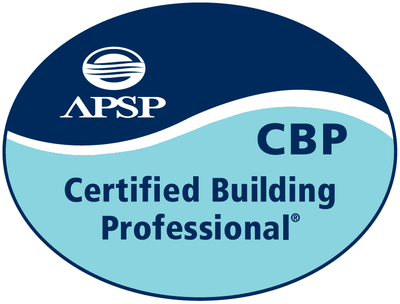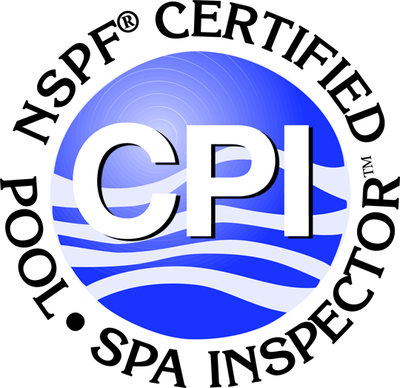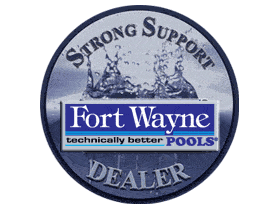There are five chemical levels that every pool owner needs to keep track of:
- FC - Free Chlorine - A sanitizer which keeps your pool water safe and free of germs. Chlorine must be constantly replenished. (# depends on CYA)
- pH - Acidity/Alkalinity - Needs to be kept in balance to prevent irritation and protect the pool equipment. (7.2 to 7.8)
- TA - Total Alkalinity - Appropriate levels help keep the pH in balance. High levels can cause pH to rise. (60 to 120, sometimes higher)
- CH - Calcium Hardness - Appropriate levels help prevent plaster damage. High levels can cause calcium scaling. (220 to 350, vinyl can be lower)
- CYA - Cyanuric Acid - Protects chlorine from sunlight and determines the required FC level. (outdoors 30 to 80, indoors 0 to 20)
There are also three other chemical levels that come up frequently enough that you should at least know what they are:
- Salt - Required with a SWG, otherwise an optional enhancement.
- Borate - An optional enhancement.
- Phosphate - Doesn't matter, despite pool store claims otherwise.
All eight are described in more detail below.
FC - Free Chlorine
Free chlorine shows the level of disinfecting chlorine available (active plus reserve) to keep your pool sanitary. Normally, FC should be tested and chlorine added daily. If you have an automatic feeder or SWG, you can test it every couple of days. FC is consumed by sunlight, and by breaking down organic material in your pool. The level of FC you need to maintain depends on your CYA level and how much you use the pool. See the Chlorine / CYA Chart for guidelines on the appropriate FC level to maintain based on your CYA level.
It is important that you do not allow FC to get too low, or you run the risk of getting algae. If FC ever gets down to zero, or you have algae, the pool is not safe to swim in. Maintaining an appropriate FC level is the most important part of keeping your water in balance.
Bleach, liquid chlorine, liquid shock, trichlor tablets/pucks/sticks, dichlor powder, cal-hypo powder/capsules, and lithium hypochlorite all raise the FC level. It is important to use bleach without any additives or special features, typically labeled unscented or "original scent". In addition to chlorine, trichlor and dichlor also add CYA, and lower the pH of the water. Cal-hypo adds chlorine and calcium. Lithium hypochlorite tends to be quite expensive. See How to Chlorinate Your Pool for information on choosing what kind of chlorine to use.
It is most efficient to raise the FC level in the evening, since none will be lost to sunlight until the next morning. FC normally goes down by itself. If you must lower the FC level quickly, you can use a chlorine neutralizer (sodium thiosulfate).
CC - Combined Chlorine
Combined chlorine is an intermediate breakdown product created in the process of sanitizing the pool. CC causes the "chlorine" smell many people associate with chlorine pools. If CC is above 0.5, you should shock your pool. CC indicates that there is something in the water that the FC is in the process of breaking down. In an outdoor pool, CC will normally stay at or near zero as long as you maintain an appropriate FC level and the pool gets some direct sunlight.
Potassium monopersulfate (a common non-chlorine shock) will often show up on tests as CC. There is a special reagent you can get to neutralize the potassium monopersulfate so you can get a true CC reading.
TC - Total Chlorine
Total chlorine is the sum of FC plus CC. Inexpensive chlorine tests, such as the common OTO test, which shows the TC level as different shades of yellow, measures TC because it is easier to test for than FC and CC. In normal operation, TC can be used as if it was FC, because CC is usually zero. You can not use the OTO test, or other tests that only measure TC, when you have algae or certain other problems. Anything that might cause the CC level to be above zero, such as algae, makes the TC level different from the FC level. In these situations, TC is useless on its own.
pH - Acidity/Alkalinity
pH indicates how acidic or basic the water is. pH should be tested daily at first. Once you gain experience with your pool, less frequent monitoring may be appropriate, depending on your pool's typical rate of pH change. pH levels between 7.5 and 7.8 are ideal, while levels between 7.2 and 7.8 are acceptable for swimming.
pH levels below 7.2 tend to make eyes sting or burn. pH below 6.8 can cause damage to metal parts, particularly pool heaters with copper heat exchange coils. High pH can lead to calcium scaling. pH contributes to the CSI, which indicates the tendency for plaster damage or calcium scaling. Aeration will tend to cause the pH to rise. This can be mitigated by lowering TA.
Many pools will drift up towards higher pH over time. This is particularly true for fresh plaster (particularly in the first month and continuing for perhaps a year) or when TA is high and the water is being aerated (because of a spa, waterfall, fountain, SWG, rain, kids splashing in the pool, etc).
You can raise pH with borax or soda ash/washing soda. Soda ash/washing soda will increase TA more than borax will. You can lower pH with muriatic acid or dry acid. How much you will need for a given pH change depends on several other numbers, most importantly your TA and borate levels. Higher TA and/or borate levels cause you to need larger amounts of chemicals to change the pH.
TA - Total Alkalinity
Total alkalinity indicates the water's ability to buffer pH changes. Buffering means you need to use a larger quantity of a chemical to change the pH. At low TA levels, the pH tends to swing around wildly. At high TA levels, the pH tends to drift up. TA contributes to the CSI which indicates the tendency for plaster damage or calcium scaling.
The ideal TA level depends on several factors. If you are using acidic chlorine sources, such as trichlor or dichlor, keep TA on the high side, perhaps between 100 and 120. If you have a SWG, or if you commonly run water features such as a spa, waterfall, or fountain, keep TA on the low side, between 60 and 80. Otherwise levels between 70 and 90 are good. Pools with plaster surfaces should factor their CSI into the preferred TA level decision. Pools with vinyl liners can tolerate high TA levels reasonably well.
You can raise TA with baking soda. It is often best to make large TA adjustments in a couple of steps, testing the water after each one, as adding baking soda will also affect the pH and you don't want the pH going out of range. If you need to lower your TA level, see How To Lower Total Alkalinity.
ATA or CTA - Adjusted or Corrected Total Alkalinity
An adjustment is sometimes made to the measured TA, subtracting out the cyanurate alkalinity, to more closely approximate the alkalinity as CaCO3. This number is only used when calculating LSI. Here at TFP you should always use the TA result directly from the test.
CH - Calcium Hardness
Calcium hardness indicates the amount of calcium in the water. Over time, water with low calcium levels will tend to dissolve calcium out of plaster, pebble, tile, stone, concrete, and to some extent fiberglass surfaces. You can prevent this from happening by keeping the water saturated with calcium. In a vinyl lined pool there is no need for calcium, though high levels can still cause problems. A plaster pool should have CH levels between 250 and 350 if possible. Calcium helps fiberglass pools resist staining and cobalt spotting. If you have a spa you might want to keep CH at at least 100 to 150 to reduce foaming. CH contributes to the CSI which indicates the tendency for plaster damage or calcium scaling.
You increase CH with calcium chloride, sold as a deicer and by pool stores, or calcium chloride dihydrate, sold by pools stores for increasing calcium. You lower calcium by replacing water or using a reverse osmosis water treatment.
TH - Total Hardness
Total hardness is the sum of calcium hardness and magnesium hardness. Most test strips report TH instead of CH. The ratio of calcium to magnesium varies. As an approximation you can multiply TH by two thirds to get a rough estimate of CH.
CYA - Cyanuric Acid
Cyanuric acid, often called stabilizer or conditioner, both protects FC from sunlight and lowers the effective strength of the FC (by holding some of the FC in reserve). The higher your CYA level, the more FC you need to use to get the same effect. It is important to know your CYA level so you can figure out what FC level to aim for. If you don't have a SWG or problems from extremely high amounts of sunlight, CYA is typically kept between 30 and 50. If you have a SWG or very high levels of direct sunlight, CYA is typically kept between 70 and 80. If you are using an ORP controller, keep CYA below 50.
You increase CYA by adding cyanuric acid, often sold as stabilizer or conditioner. CYA is available as a solid and as a liquid. The liquid costs a lot more, and generally isn't worth the extra expense. Solid stabilizer can take up to a week to fully register on the test, so don't retest your CYA level for a week after adding some. Solid stabilizer is best added by placing it in a sock in the skimmer basket. The pump should be run for 24 hours after adding solid stabilizer and you should avoid backwashing/cleaning the filter for a week.
In nearly all cases the best way to lower CYA is to replace water. If replacement water is extremely expensive you might want to look into a reverse osmosis treatment.
Salt
Salt is required with a SWG. Salt can also be added to the water to enhance the subjective feel of the water. For a SWG, check the manual for the correct salt level for your unit. This level will typically around 3,000, but different models vary. For improved water feel without a SWG, try levels around 2,000. These levels are less then one tenth of the salt level in ocean water, which has around 35,000 ppm of salt. People vary in their ability to taste low levels of salt. A few people can taste salt levels as low as 1,000, others not until 3,500 or more.
Having salt in the water just slightly increases the risk of corrosion, particularly to surfaces that water splashes onto where the water can evaporate, leaving high concentrations of salt behind. This is normally only a problem for stone work above the water line made from softer kinds of stone. There is a lack of solid information about the salt corrosion risks for many materials, leading to debate about the overall level of risk. Most people with salt in their water do not experience any problems.
Salt can be added using solar salt, sold for use in water softeners (sodium chloride). You want the kind that is 99.4% pure or better and which doesn't have any rust inhibitor or other additives. Crystals are fine. Pellets will work but dissolve slightly more slowly. Pool store salt generally costs more and is more finely ground, but even pellets dissolve quickly enough so that isn't really any advantage. Potassium chloride can be used but you will need 17% more of it and it costs more.
Borate
Borates are an optional enhancement that helps control pH drift, keeps algae in check, and provides various subjective water quality/feel improvements. If you are not intentionally using borates there is no need to test for them. When using borates, the recommended level is between 30 and 50 ppm.
With borate levels at 30 or above, there is a very remote chance that pets which drink the majority of their water from the pool might have some problems. Since pets should always be trained to not drink pool water, this shouldn't be a problem.
You increase borates by adding borax and acid, or by adding boric acid. 20 Mule Team Borax can be found in the laundry detergent section of most large grocery stores. Boric acid is available over the Internet. You lower borates by replacing water. Proteam's Supreme, Bioguard's Optimizer Plus, Omni's Maximizer, and Poolife's Endure all contain borates.
Phosphate
Phosphates are sometimes removed from the pool as a way of keeping algae in check. Since chlorine is required anyway, and chlorine alone can keep algae in check (even at very high phosphate levels), and since phosphate remover can be rather expensive and annoying to use, it doesn't make much sense to use phosphate remover except in rare and unusual situations.













